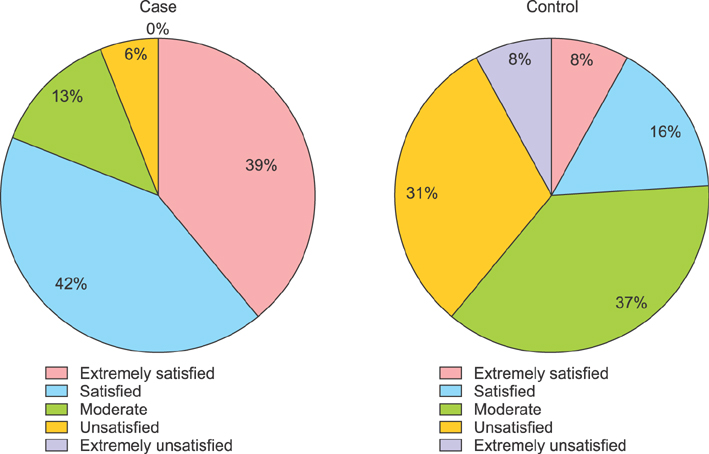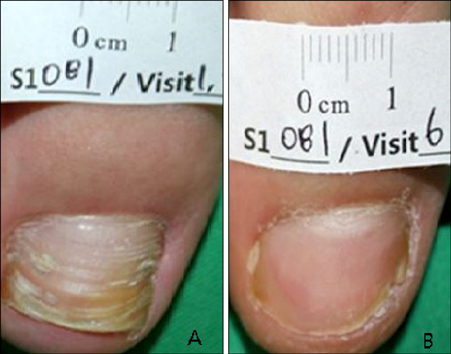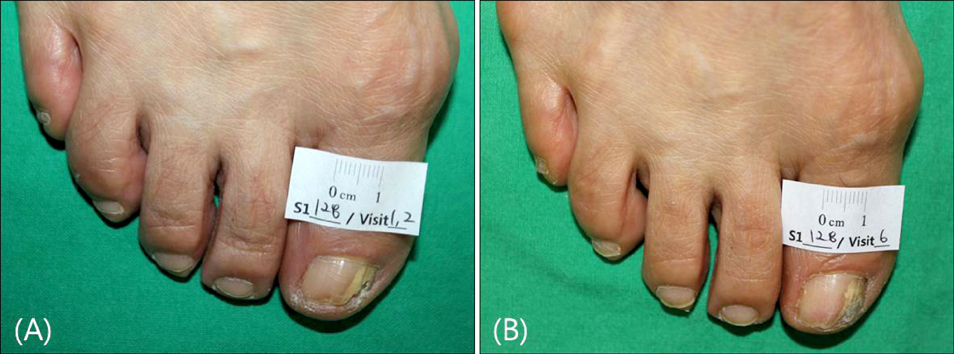Ann Dermatol.
2017 Dec;29(6):699-705. 10.5021/ad.2017.29.6.699.
Randomized Clinical Trial to Evaluate the Efficacy and Safety of Combination Therapy with Short-Pulsed 1,064-nm Neodymium-Doped Yttrium Aluminium Garnet Laser and Amorolfine Nail Lacquer for Onychomycosis
- Affiliations
-
- 1Department of Dermatology, Chung-Ang University College of Medicine, Seoul, Korea. beomjoon74@gmail.com
- KMID: 2395176
- DOI: http://doi.org/10.5021/ad.2017.29.6.699
Abstract
- BACKGROUND
Onychomycosis is one of the most prevalent fungal diseases in the general population. However, treatment is of limited effectiveness and must be administered for long periods of time. Systemic antifungal agents are associated with adverse effects.
OBJECTIVE
We evaluated the clinical efficacy and safety of a 1,064-nm neodymium-doped yttrium aluminium garnet (Nd:YAG) laser with amorolfine nail lacquer to treat onychomycosis.
METHODS
The 128 patients were randomly divided to 2 groups: 64 in the experimental group were treated with 1,064-nm Nd:YAG laser therapy and amorolfine nail lacquer; the other 64 were in a control group treated with topical amorolfine lacquer monotherapy. The laser treatment was 4 sessions at 4-week intervals and amorolfine lacquer was applied once a week for 16 weeks. Efficacy was assessed as response rate from standardized photographs with ImagePro®Plus (Media Cybernetics, Inc., USA) analysis, microscopic examination, and subjective evaluation.
RESULTS
At 16 weeks, the experimental group showed a significantly higher cumulative cure rate than the control group (71.88% vs. 20.31%, p<0.0001). Clinical therapeutic effects were linked to patient satisfaction. The percent of "very satisfied" or "satisfied" responses was higher in the test group than the control group (81.25% vs. 23.44%). The treatment regimen was well tolerated, with transient discomfort observed in the test group.
CONCLUSION
The 1,064-nm Nd:YAG laser with amorolfine nail lacquer was effective and safe for treating onychomycosis. This therapy should be considered an alternative treatment, especially for patients with contraindications to systemic antifungal agents.
Keyword
MeSH Terms
Figure
Reference
-
1. Gupta AK, Jain HC, Lynde CW, Macdonald P, Cooper EA, Summerbell RC. Prevalence and epidemiology of onychomycosis in patients visiting physicians' offices: a multicenter canadian survey of 15,000 patients. J Am Acad Dermatol. 2000; 43:244–248.
Article2. Sigurgeirsson B, Baran R. The prevalence of onychomycosis in the global population: a literature study. J Eur Acad Dermatol Venereol. 2014; 28:1480–1491.
Article3. Nenoff P, Grunewald S, Paasch U. Laser therapy of onychomycosis. J Dtsch Dermatol Ges. 2014; 12:33–38.
Article4. Ledon JA, Savas J, Franca K, Chacon A, Nouri K. Laser and light therapy for onychomycosis: a systematic review. Lasers Med Sci. 2014; 29:823–829.
Article5. Harris DM, McDowell BA, Strisower J. Laser treatment for toenail fungus. Proc SPIE Int Soc Opt Eng. 2009; 7161:1–7.
Article6. Zhang RN, Wang DK, Zhuo FL, Duan XH, Zhang XY, Zhao JY. Long-pulse Nd:YAG 1064-nm laser treatment for onychomycosis. Chin Med J (Engl). 2012; 125:3288–3291.7. Hollmig ST, Rahman Z, Henderson MT, Rotatori RM, Gladstone H, Tang JY. Lack of efficacy with 1064-nm neodymium: yttrium-aluminum-garnet laser for the treatment of onychomycosis: a randomized, controlled trial. J Am Acad Dermatol. 2014; 70:911–917.
Article8. Carney C, Cantrell W, Warner J, Elewski B. Treatment of onychomycosis using a submillisecond 1064-nm neodymium: yttrium-aluminum-garnet laser. J Am Acad Dermatol. 2013; 69:578–582.
Article9. Meral G, Tasar F, Kocagöz S, Sener C. Factors affecting the antibacterial effects of Nd:YAG laser in vivo. Lasers Surg Med. 2003; 32:197–202.
Article10. Vural E, Winfield HL, Shingleton AW, Horn TD, Shafirstein G. The effects of laser irradiation on Trichophyton rubrum growth. Lasers Med Sci. 2008; 23:349–353.
Article11. Xu ZL, Xu J, Zhuo FL, Wang L, Xu W, Xu Y, et al. Effects of laser irradiation on Trichophyton rubrum growth and ultrastructure. Chin Med J (Engl). 2012; 125:3697–3700.12. Xu Y, Miao X, Zhou B, Luo D. Combined oral terbinafine and long-pulsed 1,064-nm Nd: YAG laser treatment is more effective for onychomycosis than either treatment alone. Dermatol Surg. 2014; 40:1201–1207.13. Lim EH, Kim HR, Park YO, Lee Y, Seo YJ, Kim CD, et al. Toenail onychomycosis treated with a fractional carbondioxide laser and topical antifungal cream. J Am Acad Dermatol. 2014; 70:918–923.
Article14. Gupta AK, Ryder JE, Johnson AM. Cumulative meta-analysis of systemic antifungal agents for the treatment of onychomycosis. Br J Dermatol. 2004; 150:537–544.
Article15. Schwartz RA, Janniger CK. Onychomycosis. Cutis. 1996; 57:67–74. 80–81.16. Borgers M. Mechanism of action of antifungal drugs, with special reference to the imidazole derivatives. Rev Infect Dis. 1980; 2:520–534.
Article17. Reinel D. Topical treatment of onychomycosis with amorolfine 5% nail lacquer: comparative efficacy and tolerability of once and twice weekly use. Dermatology. 1992; 184:Suppl 1. 21–24.
Article18. Helou J, Maatouk I, Hajjar MA, Moutran R. Evaluation of Nd:YAG laser device efficacy on onychomycosis: a case series of 30 patients. Mycoses. 2016; 59:7–11.
Article19. El-Tatawy RA, Abd El-Naby NM, El-Hawary EE, Talaat RA. A comparative clinical and mycological study of Nd-YAG laser versus topical terbinafine in the treatment of onychomycosis. J Dermatolog Treat. 2015; 26:461–464.
Article20. Hees H, Raulin C, Bäumler W. Laser treatment of onychomycosis: an in vitro pilot study. J Dtsch Dermatol Ges. 2012; 10:913–918.
Article21. Manevitch Z, Lev D, Hochberg M, Palhan M, Lewis A, Enk CD. Direct antifungal effect of femtosecond laser on Trichophyton rubrum onychomycosis. Photochem Photobiol. 2010; 86:476–479.
Article22. Paasch U, Mock A, Grunewald S, Bodendorf MO, Kendler M, Seitz AT, et al. Antifungal efficacy of lasers against dermatophytes and yeasts in vitro. Int J Hyperthermia. 2013; 29:544–550.23. Li RY, Wan Z, Wang AP, Shen YN, Lu CM, Li M, et al. In vitro susceptibility testing of amorolfine in pathogenic fungi isolated from dermatomycosis patients in China. Mycoses. 2004; 47:402–406.
Article
- Full Text Links
- Actions
-
Cited
- CITED
-
- Close
- Share
- Similar articles
-
- Treatment Outcomes of Combination Therapy with 1,064-nm Neodymium-doped Yttrium Aluminum Garnet Laser and Efinaconazole 10% Solution for Big Toenail Onychomycosis: a Retrospective Study
- 1,064-nm and 532-nm picosecond neodymium-doped:yttrium-aluminum-garnet laser treatment for longitudinal melanonychia: a case report
- Intense Pulsed Light and Q-Switched 1,064-nm Neodymium-Doped Yttrium Aluminum Garnet Laser Treatment for the Scarring Lesion of Discoid Lupus Erythematosus
- Therapeutic effect of long-pulsed 1,064-nm Nd:YAG lasers on venous lakes in Korean patients: a case report
- Duration Period of Treatment Effect of the 1,064 nm Neodymium-doped Yttrium Aluminum Garnet Laser to Treat Onychomycosis




